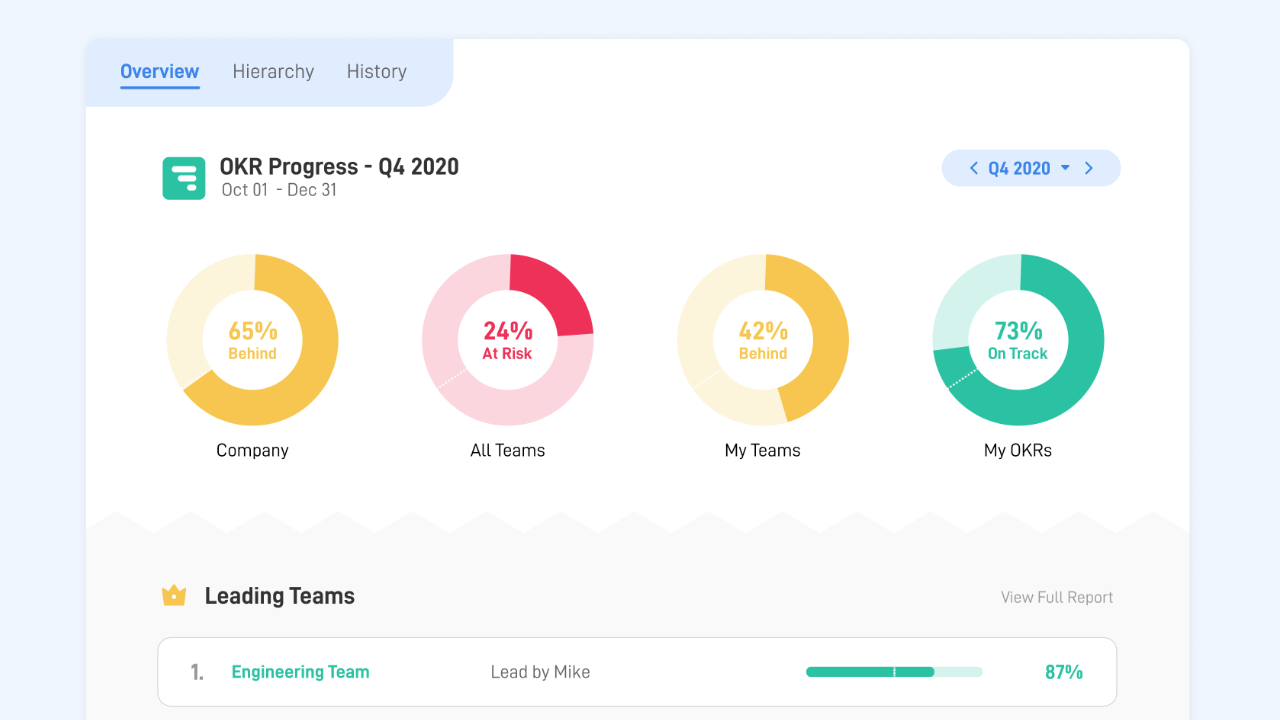Objectives and Key Results (or OKRs) caused a buzz in the tech scene when all the biggest Silicon Valley companies started using it in the early 2000s. Google, Twitter, Netflix, LinkedIn, etc. – it almost seems like setting OKRs is the secret sauce behind these startups’ massive success. Today, the most innovative and high-performing companies – from startups to MNCs – use OKRs to drive organizational goals. Most of them made plenty of common OKR mistakes when they started, before becoming successful with them.
The OKR system is a fantastic goal-setting methodology that separates itself from the pack for its simple, no-fluff, agile approach to working towards your goals. By clearly defining business “objectives” and “key results,” companies get a clear vision of what they’re striving to achieve, and how they can go about doing it.
While the OKR concept is seemingly simple to understand, implementing OKRs is a whole different story. OKR mistakes happen (very) often and if ignored, will not only defeat the purpose of doing OKRs, but will result in unnecessary time and resources wasted to correct them.
So if you’re new to OKRs or you’re finding that they’re just not working for your company, look through this list and ensure you’re not making any of these common OKR mistakes.
#1: You aren’t shooting high enough
One common OKR mistake is to set conservative goals, or goals that would be nice to achieve but don’t challenge your team enough. This is called “sandbagging.”
Sandbagging is common because risk-averse goal-setting is typical in other popular methodologies, like Management by Objectives (MBO) and Balanced Scorecard (BSC) approaches, where your compensation is tied strongly to whether or not you hit those goals. People who are coming from these frameworks may find it hard to adjust to the ambitious, shoot-for-the-stars nature of OKRs.
The OKR platform however is all about setting stretch goals that are not tied to employee compensation (see point #9). In his book Measure What Matters, OKR pioneer John Doerr quotes Google’s Larry Page: “If you set a crazy, ambitious goal and miss it, you’ll still achieve something remarkable.”
For example, if your goal is “to become the #1 fashion e-commerce retailer in Southeast Asia”, you will likely work harder than if your goal was just to “to be one of the top 10 fashion e-commerce retailers in Southeast Asia”.
So don’t set objectives that you’re sure your team can achieve. You’re short-changing the business. Build a culture of innovation and creativity, and encourage your teams to go all out and be unafraid to make mistakes. If your team is always completing 100% of their goals, that may be a sign that your goals are too easy, and you should adjust your goalposts. In the OKR system, 70-80% completion of an objective is considered a good (and ideal) achievement.
#2: You’re shooting way too high
On the flip side of the spectrum, if your team is consistently hitting way below 70% completion of objectives, then you may have set your goalposts way too far.
There’s a difference between a challenging goal and an impossible goal that’s beyond what’s achievable given the time and resources currently available. If you’re a brand new player and you’re already gunning to be the top fashion e-commerce retailer in Southeast Asia this year, you’re just going to be disappointed.

“Hitting a target” – an impossible goal for a Stormtrooper
This is where the leaders and managers of the organization come in. They need to understand the vision and goals of the business, and the resources required to get there. Regularly failing to hit your objectives can be very demoralizing for the team.
An OKR best practice is to write objectives that are ambitious, inspirational, concrete, and action-oriented. If you meet all these criteria, you will have a better measure of objectives that count as both aggressive and potentially attainable.
#3 You’re only taking care of aspirational OKRs
There are two main types of objectives in OKRs: committed and aspirational – sometimes also referred to as “roofshots” and “moonshots,” respectively.
Committed OKRs are top priority goal-setting commitments for the given quarter that owners are obligated to achieve them 100% (OKR score of 1.0). Contrast this to aspirational OKRs that are bolder in nature, and likely only 70-80% achievable.
It’s easy (and kinda fun) to focus only on dreamy, visionary aspirational OKRs, but you also need look out for any fundamental areas that require committed OKRs. For example: fixing an important SLA (service level agreement) issue that customers are complaining about; solving the security problem that’s plaguing the entire infrastructure; or ensuring a major event is a success.
Committed objectives maintain the minimum level of performance expected of your company. Therefore, contrary to stretch goals (see point #1), owners of these committed goals are required to hit an OKR score of 1.0 (100%).
So dream big, but don’t neglect the fundamentals!
Note: Even though roofshots have to be fully realized (100%), they still need to be challenging. You can do this by pushing your key results to become even more ambitious each time you hit your targets. Otherwise, then can be treated as “business as usual” and removed from the OKR list.
#4 You mix up your objectives with your key results, and your key results with initiatives
When it comes to setting OKRs, wording is everything. Objectives must answer the “what,” and key results the “how.” If you’re coming from another goal-setting methodology, it’s easy to mix up key results with objectives – a common OKR mistake. In MBO, for instance, “Increase customer satisfaction by 15% in 2021” would count as an objective. But in OKR, that’s a key result.
An appropriate objective in this instance could be something like “Deliver world-class customer support experiences”, in which a “15% increase in customer satisfaction” would be one indicator of success (key result) in meeting that objective.
See how tricky that can be?
When coming up with OKRs, keep in mind that objectives express high-level goals and intents that offer clear value to your business. And key results express actual quantifiable/measurable milestones with clear metrics that lead to achieving your objective.
Once you’ve established your objectives and key results, “initiatives” are the clear actions you need to do to achieve those key results. Because initiatives are the laundry list of to-dos carried out day-to-day by individuals, they do not need to be spelled out publicly in the OKRs.
#5 You’re setting too many OKRs per quarter
When coming up with goals and objectives for your business, it’s easy to get carried away with all of your aspirations – you want to have a stellar team, offer the best customer service, become the leader in your industry, etc. But having too many OKRs can do you more harm than good because it divides your limited focus, time and energy.
The OKR platform is all about cutting through the clutter and focusing only on high-value objectives that will propel your company towards its ultimate vision. If you’re juggling five or ten objectives each quarter, then you’re likely diluting your focus. And that can lead to missed goals and wasted efforts. Remember, if everything is a priority, then nothing is a priority.

No one’s good at juggling. Except maybe this guy.
The same goes for your key results. Focus on the key results that accurately represent the success of your objective. Having too many key results could spread your efforts too thin, and having too few key results would give you an incomplete representation of the success of your objective.
Constantly remind yourself that OKRs are not to-do lists. They represent your ultimate vision, just in a distilled form. Try to keep just three to five objectives per team, with three to five key results per objective.
#6 You’re setting low-value business objectives
Another danger of setting too many OKRs, is writing low-value objectives (LVOs) – also known as “Who cares?” OKRs.
These LVOs are so named because they are objectives that make little to no impact on your overall mission as a company; objectives that, even if completed, may go unnoticed because that’s how low of a value they are.
So how do you avoid creating LVOs?
Before the start of the new quarter, remind yourself of your company’s overall mission and vision, and ask yourself if this OKR brings you one step closer to that. Consider why you put that down as an objective in the first place. Did you list it because other companies are listing it? Or is there a broader mission to it?
Once again, leaders and managers play a key role here in not only setting the overall vision and direction of the company, but also communicating that clearly to every single person in the company.
#7 You review progress irregularly and infrequently
Review-learn-iterate – that’s the cycle of an OKR. While objectives are set every quarter, OKRs require weekly or at least bi-monthly check-ins to make sure the team (and everyone) is on track. It might feel like a chore to get that calendar invite every week, but measuring progress is a crucial aspect of setting OKRs – you only have to think about your New Year’s resolutions to understand why.
OKRs also encourage teams to be flexible and iterative in their approach to achieving their goals. By sitting down regularly with your team, you can discuss what worked, what didn’t, and why. This will not only prevent any arising problems from ballooning into disasters (that will make them even more difficult to fix), but you will learn from these OKR mistakes and prevent them from happening again in the future.
Bottom line: Never set-and-forget your OKRs. Get into the good habit of weekly meetings/updates, and quantify progress with clear metrics.
#8 You set OKRs in silos
If you’re setting OKRs for your department or team without discussing them with anyone within or outside of the team, then you’re missing the point of OKRs.
The purpose of OKRs is to drive your company towards a unified vision, and breaking down that vision into smaller, more attainable objectives that steers everyone in the right direction.
When setting OKRs in silos, there’s a danger of teams working towards objectives that are redundant/irrelevant to the vision, or offer no real value to the organization.

You really wanna work in one of these?
Hearing “Wait… why are we working on this again?” too many times internally is a signal that teams are working in silos and going all over the place.
To avoid this OKR mistake, always discuss your OKRs (during the planning phase) with stakeholders within and outside your team to ensure that functional OKRs are aligned across the organization. That way, everyone knows what is going on, nobody is confused, and there are no miscommunications.
#9 You connect OKRs with performance bonuses
It might seem sensible to connect your objectives with performance evaluations to incentivize hitting goals, but this is actually a big OKR mistake. If you want people to aim high and reach for the stars, you need to take away the fear of failure.
Goals and objectives in the OKR world are designed to be aspirational. If people’s bonuses keep getting cut in half because of goals they can’t fully achieve, they would be more inclined to lower the difficult level of their objectives so as not to sacrifice a part of their paychecks.
Note: It’s still reasonable for managers to tie some compensation aspects to certain committed-type OKRs (e.g. sales targets). Just make sure you have a good mix of both committed and aspirational OKRs (see point #3).
#10 You expect immediate results
So you’ve been doing OKRs for over a year now – are you wondering why you’re not at Google’s level yet?
OKRs, like any goal-setting methodology, take time to implement and OKR mistakes will be made. You’ll probably get used to setting and implementing OKRs effectively only after a few quarters.
OKRs are also deeply entrenched in a company’s unique vision, mission, and people. And while OKRs allow you to reach your goals in a more agile, flexible, and cohesive fashion, it would be unrealistic to assume your business will automatically follow the same trajectory as other companies that use OKRs.
Therefore, as with all things good, give it time. Patience and perseverance are key ingredients to honing your organization’s “OKR skills”, and building a strong culture of innovation, creativity, and accountability.
SugarOKR is a beautifully simple and easy-to-use free OKR management tool that helps teams unlock the full potential of OKRs, while staying focused and motivated. To find out how your company can win with OKRs, visit us at sugarokr.com.





